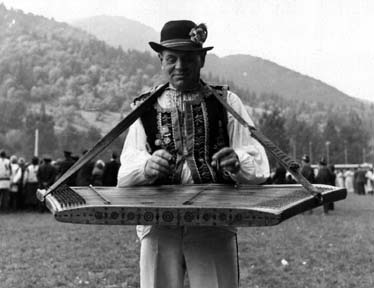I usually mention concerts if they involve beloved friends or something really worth seeing. Well, I forgot to post about OBI's concert last week in Minneapolis at the locally cherished Cedar Cultural Center, the best place to catch real folk troupes from around the world playing in Minneapolis. For example, over the years a number of Hungarian ensembles have toured the US and stopped by there. Some of those troupes had members who were real, village-based players with no university training in music at all; otherwise, all of them had members who had trained in villages with real village players as part of their schooling. Hungary is one country whose presentation of folk dance and music was transformed by a back-to-the-village /authenticity movement (i.e., they threw out the Bullshitski-style or the formalism that had made folk dancing into character ballet). Ensembles in Bulgaria--from the state ensemble on down--also have a strong, village-based style, and Hungarian and Bulgarian troupes continue to be exemplary for authenticity enthusiasts who like to see staged performances of folk dancing.
However, there are some real hard-nosed authenticity-folk for whom going to a show is frivolous: either you participate in the music-making and dancing, or you watch real people in real settings really doing it all, or you just forget about it. That's not me, but I understand the impulse to participate and have it be real rather than sit back and consume. I guess that's why I am a performer. They are a minority within a minority.
(For me, the real test of a troupe's value is this: Do I feel like I am watching people in a village or at a wedding dancing, albeit in a village or at a wedding where everyone is a really good dancer? If there are pointed toes and obvious ballet moves, or if it is all too obvious that the dancers have lots of ballet training, I feel cheated. If this does not help explain things, then you really have to watch either the state ensemble of Hungary or Bulgaria to get a sense ofwhat I mean. Unfortunately, no Ukrainian troupe that I have seen has matched this style; however, I have certainly not seen every troupe there is to see. . ..)
All of this stuff that I have talked about on this blog about authentic v. the kitch of the Sovietski-Bullshitski style is true about American folk music, too. Bluegrass is the American folk music version of Sovietski-Bullshitski (since we are talking about a process of modernizing the peasants and making kitch of their culture for a broader, bourgeois audience that took place everywhere throughout the 20th century). There are plenty of olde-tyme music enthusiasts who don't care much for Bluegrass (while there are plenty who like both styles). The real thing from which both olde-tyme and Bluegrass music derive is often called the "American-primitive style" by knowledgeable folk music lovers in the US. (Olde-tyme music, however, is incomparably closer to real, so-called "primitive" playing than flashy and schooled Bluegrass stuff.)
Anyhow, those Hungarian shows were fantastic, as was OBI's. . .lots of great playing and dancing.
Personally, I am enthusiast of Carpathian Mountian region dances, while Hungarian- Transylvanian and Hutsul music and dance are my true passion and first love(s).

PS--If you are in Kyiv, ask around for info about where and when you can catch a show or a folk dancing night at which either Buttja or Bozhychi will be playing. Also, there is a place in Kyiv to go recreational folk dancing with live, real folk music every Friday (or at least, it used to be every Friday). Email me and I will tell you where it is (the locale is small, and I don't want to send anyone there who isn't serious about wanting to participate in or learn more about real Ukrainian dancing and music). There are a few other music troupes out there that I know about and lots of other ways to experience real folk music and dance in Ukraine, but I am tired of writing for now. . .






2 comments:
Hey Adrian,
Great to find a fellow traveler of this world with similar passions! We are indeed members of a select group with such passions, though it is not that select: I have Uki-American friends in the Ethnic Dance Theater and other groups who have a passion for both American and Ukrainian folk music, and do you know who Peter Ostroushko is? The fairly well known player in the world of American folk who is of Uki-American background? (btw, he's from Minneapolis, too; my dad "grew up" after coming to the US on the same street; and oh, my tato is also a huge fan of Bluegrass/Old Time, especially of the Stanley Bros).
Before I write out a response-- because I would love to engage in a conversation about this subject matter with a fellow Bluegrass-Old Time player and Ukrainblogger--I do want to ask, do you accept, however, that there is a difference--a to my mind major distinction of style and emphasis-- between Old Time and Bluegrass?
I ask this because, as I am sure you well know, there are those who want to erase the distinction between the two completely, claiming that it is false and that the two terms merely reflect different ways of talking about the same thing. I overall disagree with that sentiment, so I'd like to know if we should begin even there, before getting into the issue of what is derivative and what is not, etc.
Btw., have you see the movie Decline of Western Civilization Part I, about the punk scene of LA in the late 70s/early 80s? A guy in that film made the statement, "I got news for the world, there is no such thing as New Wave." For him, it was all just punk. This too has been the source for years of a similar debate for me; as a punk rockin' kid I disagreed, and still do today (though I liked both punk and New Wave, I still like punk better)!
And oh, one other thing: I do see a similar process effecting traditional music in the US and the USSR (and in Central and Western Europe)in the early XXth century. Whether the State or the Record Company/Radio Producer mandated it, music that had roots in village playing underwent a profound transformation when it was recorded or performed live. There was a profound change brought about by what I call an intensification of the "performance imperative" within the music already that meant certain sounds and styles were selected over others, and the rawness of village playing was increasingly eliminated in favor of an evermore more harmonious and nice-to-listen-to form that eventually became Bluegrass, and which filtered back toward the village and affected how people played traditionally, even well before there was anything like Bluegrass around (you are quite right to point out).
As a hint to a future response, to my mind Bluegrass, especially as it is played today, is a hyperperformative version of folk music, while Old Time, though also quite influenced indeed by technology, has striven and continues to strive as a tradition much less based on a performance imperative. (This is the sense in which those who want to erase even the distintion between Old Time and Bluegrass are rather right; the two terms do refer to two approaches to playing/performing music coming from the same source; to me, the difference is big enough to say the distinction is necessary, even though it is a distinction within a certain strand of American folk music). But back to the matter of performance imperative: In Old Time today there are no three minute song formats and no (to my mind oppresive, but of course that is just me, but it's also not the way things would have been in the village) emphasis on pretty harmonies and pluckin' as many notes as can be crammed into a tune.
I am obviously showing my biases. Though performance driven music has its time and place, too, it's not that interesting to me, and it is quite removed from whatever the village style was, which is what interests me. . .
One of the things that is different in the US from what obtained and obtains in Eastern Europe is that we don't have big folk ensembles presenting to the public, "Hey, this is our traditional folk music and dance." If there was say, a US State Folk Ensemble and what I saw was people dancing in a style somewhere in between character ballet and real clogging, and were doing it all too Bluegrassy music, I would think to myself, "This country needs a back to the village movement. . ."
What we do have however, are some really great, little groups all over the place that do things the right way, in my opinion (gosh, maybe I am too pigheaded about all this!), such as the Wild Goose Chase Cloggers here in Minneapolis. When I see them and listen to the music to which they perform, I do feel like I am in a village--or like I am sittin' 'round the campfire at a Bluegrass/Old Time festival!
The parallel with Ukraine is like this: so I grew up hearing made-for- the-record Ukrainian music and never heard rawer versions (except for the singing in my family, at scouting meetings, and Uki School). So I never really heard what would be the equivalent of Old Time for instrumental Ukrainian folk music, nor heard what would have been even better, recordings of people playing in a village, until I joined the Ethnic Dance Theater. One of the strongest, most spiritual experiences of my life is when I finally arrived in Ukraine and got to hear village-style, not record nor stage-style, playing of Ukrainian music for the first time in Pidhajtsi and then in the mountains. It was incredible.
One summer later, I saw one of the same troupes playing in a restaurant in the same style as I heard on records or at dance concerts while growing up. They could play in both a village based and more performance based style (or touristy-restaurant based) style. There is a real distinction. One style is much more connected to the village while the other was invented for the stage or the recording/radio, even though this latter style was often played by one and the same person who could or did play in the other style, as you mentioned in connection to American music (i.e., the Monroes, Stanleys, Carters, et al). One and the same player could play differently according to his audience and context.
That is, a friend, who is a an accomplished Bluegrass/Old Time as well as Bulgarian player had this to say: Bluegrass is the preserve of those who perform for the sake of performance, while Old Time is the perserve of tradition. He also tells the story of meeting a Gypsy guy in Budapest who was playing for guests in a hotel restaurant; my friend went with the Roma player back to his village in Transylvania and witnessed him playing similar music but in a completely different style.
Of course, a lot of the recorded style—and what is more, songs that were invented only to be recorded with no roots in any village anywhere—right away began filtering its way back to the villages. I am not a folk nazi enough to imagine that I can tell you what can or can't be played because such and such are new songs. No way. The music does have to change and grow. But there is a real difference in how the music is presented and played, a major difference of style.
I guess I made my response at the end after beginning with a question!
Glad to share this passion with you.
Oh, but one more thought: Zinta, Julija's mama, is an accordionist/pianist/singer/guitarist/etc. from a family that has been intimately part of the back-to-the-village or "folklore" movement within Latvian performing folk arts, and to her mind there is a distinction between folk and "post-folk" music, whereby post-folk refers to performance-driven music. She is involved in post-folk stuff as well, but she still sees there being a flow within Latvian folk music that is closer to tradition and less based on performance, or the performance imperative.
Does this make sense? Am I contradicting myself all over the place? Why, then, do I usually feel nonplussed while watching the guys/gals on stage at a Bluegrass/Old Time festival or while listening to them on Bluegrass radio shows, and feel totally inspired when sitting around the fire at the same festivals, or in on a session at a local coffeehouse? The inspiration and excitement is similar to what I felt in villages and small towns in Ukraine, and the feeling of indifference was similar to what I felt when, after being in Pidhajtsi for so long, I heard the same songs played in a more nice-nice style in Kyiv. (I thought, oh, that's nice for the tourists; however, I have much more love for that music than the nice-nice version of American folk, which perhaps I am glossing far too liberally as all “Bluegrass”. . .
reactions, input, please!
Thanx for the link and response. . .I will go have a listen. . .
One more thing to add: I guess I should qaulify all this with the statement, if what I am expecting to, or am told that what I am about to, hear is folk music, then what I expect/want to hear is the Old Time style. Otherwise I love Bluegrass and performance based folk music just fine! If I expect to hear Bluegrass or any other more modern updated stuff, OK, well, the fine! Let's have a listen! Let's be creative. . .I definitely was being too universal. . .I guess I was really talking about performances that are geared toward presenting such and such as the tradition of a nation's folk music. . .and people who confuse Old Time style and Bluegrass, tradition v. performance style (though there is the crossover. . .)
'Cause otherwise, I do dig listenin' to a lot of different music, even if the village-style stuff of Ukraine and the Appalachians is closest to my heart. . .
Post a Comment